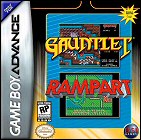 The Game: DSI strikes again with Gauntlet and Rampage, two nearly perfect arcade conversions for the Game Boy Advance. In Gauntlet you’ll trade shots with ghosts, demons, and Death himself. In Rampart you’ll defend your ground and exchange buckshot with more worldly enemies. (DSI Games/Atari, 2006)
The Game: DSI strikes again with Gauntlet and Rampage, two nearly perfect arcade conversions for the Game Boy Advance. In Gauntlet you’ll trade shots with ghosts, demons, and Death himself. In Rampart you’ll defend your ground and exchange buckshot with more worldly enemies. (DSI Games/Atari, 2006)
Memories: Gauntlet will be forever imbedded in my mind as the first four-player cooperative quarter eater. From the day I first saw it way back in seventh grade, the game has always held a special place in my heart. At least that’s the story I told my wife as I was moving a vintage Gauntlet arcade cabinet into our home gameroom.
 DSI’s port of Gauntlet to the Game Boy Advance is surprisingly good. The speech samples, the sound effects, and graphics are all on par with the original. In fact, the Game Boy version’s only two flaws come from porting the game to a Game Boy. One, the game’s entire structure (insert quarters for more life) has never worked on home consoles, and it doesn’t work here either. Some versions allow you to insert virtual coins to add as much health as you want; this version doesn’t allow for any additional coins, although you are allowed to continue after dying. Fortunately the game starts players out with 10,000 health, which should be more than enough for almost any gaming session. The other problem comes from taking one of the arcade’s most famous multiplayer games and turning it into a single-player game. While the game is certainly playable in single-player mode, it’s not nearly as much fun. Other than that, the only thing conspicuously missing is the between-level music.
DSI’s port of Gauntlet to the Game Boy Advance is surprisingly good. The speech samples, the sound effects, and graphics are all on par with the original. In fact, the Game Boy version’s only two flaws come from porting the game to a Game Boy. One, the game’s entire structure (insert quarters for more life) has never worked on home consoles, and it doesn’t work here either. Some versions allow you to insert virtual coins to add as much health as you want; this version doesn’t allow for any additional coins, although you are allowed to continue after dying. Fortunately the game starts players out with 10,000 health, which should be more than enough for almost any gaming session. The other problem comes from taking one of the arcade’s most famous multiplayer games and turning it into a single-player game. While the game is certainly playable in single-player mode, it’s not nearly as much fun. Other than that, the only thing conspicuously missing is the between-level music.
 Rampart is a completely different style of game from Gauntlet. I fell in love with the game’s combination of strategy and action the first time I played it in the arcade, and ever since it’s held a special place in my heart. At least that’s the story I told my wife as I was moving a vintage Rampart arcade cabinet into our home gameroom. I have a very loving and understanding wife.
Rampart is a completely different style of game from Gauntlet. I fell in love with the game’s combination of strategy and action the first time I played it in the arcade, and ever since it’s held a special place in my heart. At least that’s the story I told my wife as I was moving a vintage Rampart arcade cabinet into our home gameroom. I have a very loving and understanding wife.
Rampart consists of two different game sequences. After choosing a castle to defend, you’ll have to fire you castle’s cannons at a fleet of ships that are firing back at you as well. Each  well-placed shot from an enemy takes a randomly sized chunk out of your castle’s outer perimeter. This phase of the game takes place for around a minute. Once completed, you’ll get a short amount of time to rebuild your castle. I’ve always felt this phase of the game resembled Tetris. The game hands you randomly sized and shaped pieces that must be rotated and used to repair the damage to your wall. If you do not completely repair the damage to your castle before the timer expires, the game is over. Repair your castle and the game continues. There are also other castles near yours that can also be encapsulated. As you expand your territory you’ll earn additional cannons, which means more firepower in the wartime rounds. The game continues until you fail to repair your castle’s walls, or you destroy all the enemies and move to the next round.
well-placed shot from an enemy takes a randomly sized chunk out of your castle’s outer perimeter. This phase of the game takes place for around a minute. Once completed, you’ll get a short amount of time to rebuild your castle. I’ve always felt this phase of the game resembled Tetris. The game hands you randomly sized and shaped pieces that must be rotated and used to repair the damage to your wall. If you do not completely repair the damage to your castle before the timer expires, the game is over. Repair your castle and the game continues. There are also other castles near yours that can also be encapsulated. As you expand your territory you’ll earn additional cannons, which means more firepower in the wartime rounds. The game continues until you fail to repair your castle’s walls, or you destroy all the enemies and move to the next round.
 The original arcade version of Rampart used a trackball controller. The game was later converted to work with joysticks, but it always worked best with the original trackball system. That becomes the weakest link in Rampart‘s own defenses; controlling your cannon’s aim accurately and sinking enemy boats is nearly impossible because the cursor simply moves way too quickly. Other than that, everything else is great. Rampart is probably DSI’s most accurate arcade translation to date.
The original arcade version of Rampart used a trackball controller. The game was later converted to work with joysticks, but it always worked best with the original trackball system. That becomes the weakest link in Rampart‘s own defenses; controlling your cannon’s aim accurately and sinking enemy boats is nearly impossible because the cursor simply moves way too quickly. Other than that, everything else is great. Rampart is probably DSI’s most accurate arcade translation to date.
 Despite the games’ minor drawbacks, they’re both still really, really fun. Plus, they take up much less space and are much more portable than their full-sized big brothers, which would be a selling point to people with wives less understanding than mine.
Despite the games’ minor drawbacks, they’re both still really, really fun. Plus, they take up much less space and are much more portable than their full-sized big brothers, which would be a selling point to people with wives less understanding than mine.
